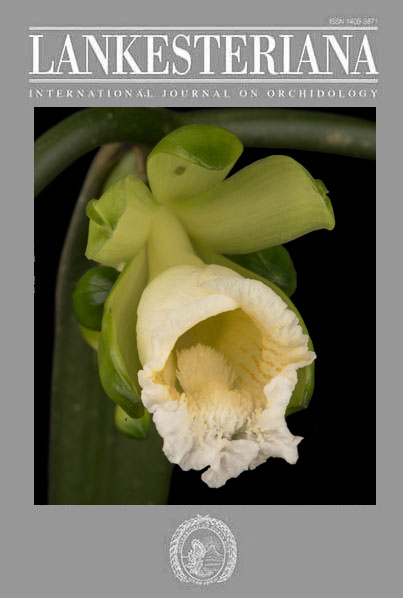A reappraisal of Neotropical <i>Vanilla</i>. With a note on taxonomic inflation and the importance of alpha taxonomy in biological studies
DOI:
https://doi.org/10.15517/lank.v20i3.45203Abstract
Despite the long-standing cultural importance and botanical interest in Vanilla, many taxa belonging to the genus remain poorly understood. Vanilla species generally have broad geographical and ecological distributions. Most species are found in multiple countries, while local endemics are rare. Many names proposed in the eighteen and nineteenth centuries remain cryptic and unused despite having priority over more recently proposed names. Relatively few Vanilla species have been well-documented, both locally and across their entire distribution range, while a significant portion of novelties have been proposed on the basis of very few specimens that are compared only with local floras. After a careful inspection of the type materials, living plants, botanical illustrations, photographs and hundreds of additional herbarium specimens of Vanilla we tentatively recognize 62 species for the Neotropics. The taxonomy of Vanilla columbiana, V. hartii, V. inodora, V. karenchristianae, V. marowynensis, V. mexicana, V. odorata, V. phaeantha, V. planifolia, and V. pompona is revised. An updated typification, description, photographs, illustrations, list of studied specimens, distribution map, extent of occurrence and discussion is provided for each of the ten species. Taxonomic proposals include 28 new synonyms, 14 lectotypifications, and one neotypification. We stress on the importance of alpha-taxonomy for biological studies, emphasizing on the detrimental effects of taxonomic inflation and incorrect species determination on the inference of speciation rates, the understanding of biogeographical patterns, the correct estimation of ecological niches, seed dispersal studies, phylogenetic and genomic studies, and the assessments of conservation priorities, among others. Finally, the recently proposed genus Miguelia is placed under the synonymy of Vanilla.
Key Words: Conservation, distribution, Miguelia, typification, Vanilla columbiana, V. hartii, V. inodora, V. karen-christianae, V. marowynensis, V. mexicana, V. odorata, V. phaeantha, V. planifolia, V. pompona
Downloads

Downloads
Published
How to Cite
Issue
Section
License
According to the Open Access policy promoted by the University of Costa Rica, all the papers published by Lankesteriana are licensed under the Creative Commons copyright and can be downloaded free of charge. The journal holds copyright and publishing rights under the CC BY-NC-ND 3.0 CR license.
Before the publication of the materials submitted by the author(s) in LANKESTERIANA, the author(s) hereby assign all rights in the article to the Lankester Botanical Garden.




